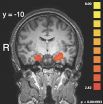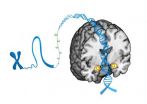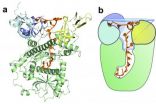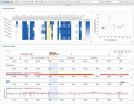(Press-News.org) Although mutations in a gene dubbed "the guardian of the genome" are widely recognized as being associated with more aggressive forms of cancer, researchers at the University of California, San Diego School of Medicine have found evidence suggesting that the deleterious health effects of the mutated gene may in large part be due to other genetic abnormalities, at least in squamous cell head and neck cancers.
The study, published online August 3 in the journal Nature Genetics, shows that high mortality rates among head and neck cancer patients tend to occur only when mutations in the tumor suppressor gene coincide with missing segments of genetic material on the cancer genome's third chromosome.
The link between the two had not been observed before because the mutations co-occur in about 70 percent of head and neck tumors and because full genetic fingerprints of large numbers of cancer tumors have become available only recently.
"These two genetic malfunctions are not two separate stab wounds to the body," said co-senior author Trey Ideker, PhD, chief of the Division of Genetics. "One exposes the Achilles tendon and the other is a direct blow to it."
To patients with these cancers, the study's results mean that there may be therapeutic value in testing tumors for the two genetic identifiers, known as a TP53 mutation (short for tumor protein 53) and a 3p deletion (short for deletions of genetic information on the short arm "p" of the third chromosome).
TP53 plays a key role in regulating cell growth, detecting and fixing DNA, and directing cell apoptosis (death) if the DNA damage is irreparable. Because of this, the TP53 protein is sometimes called the "guardian of the genome."
The study's findings suggest that if both markers are present, treatment should be intensified. If only one mutation is present, treatment might be de-intensified because the TP53 mutation alone is less deadly than previously thought. The latter would have immediate benefits in reducing deaths caused by complications related to medical care.
"We are in the early stages of being able to personalize head and neck cancer treatments based on the tumor's actual biology, the same as what's done with breast cancers," said co-senior author Quyen Nguyen, MD, PhD, associate professor of Otolaryngology-Head and Neck Surgery. "In the past, treatments have been based largely on the size and location of the tumor. Now, we know that some large tumors may respond to less aggressive treatment while some small tumors may need intensified treatment. This will have a huge impact for patients."
The study analyzed the complete genomic signatures of 250 cases of squamous cell head and neck cancer extracted from The Cancer Genome Atlas, a repository of sequenced cancer genomes for more than 20 different types of human cancers maintained by the National Institutes of Cancer. All of the tumors were from patients younger than 85 years of age.
Of these, 179 had both mutations; 50 had one of the two mutations; and 22 had neither mutation. Comparisons with patient outcome data showed that half of patients with both mutations would likely die of cancer within 2 years, while 66 percent of patients with one or neither mutation would be expected to live five years or more. These survival statistics were independent of the patients' clinical cancer stage.
Besides causing cervical cancer, the human papilloma virus (HPV) is implicated in the growing epidemic of head and neck cancers in otherwise healthy adults. It is believed that the virus can co-opt the activity of TP53, affecting cells in much the same way as a TP53 mutation but without causing a mutation. For this reason, the analysis examined HPV-positive and HPV-negative tumors separately.
One of the study's more compelling discoveries is that among HPV-positive tumors, the most aggressive cancer cases were also highly linked to the presence of 3p deletions.
"Our findings raise fundamental questions about the role of TP53 in cancer and suggest that some of the deleterious health effects of TP53 mutations might actually be due to something else going on in the third chromosome," said lead author Andrew Gross, a graduate student in the Bioinformatics and Systems Biology Program.
INFORMATION:
Co-authors include Ryan K. Orosco, John P. Shen, Hannah Carter, Matan Hofree, Michel Choueiri, Charles S. Coffey, Scott M. Lippman and Ezra E. Cohen, UC San Diego; Ann Marie Egloff and Jennifer R. Grandis, University of Pittsburg; and Neil Hayes, University of North Carolina.
Funding for the study was provided, in part, by the National Institutes of Health (grants P50 GM085764, P41 GM103504 and U24 CA184427), Burroughs Welcome Fund and The American Cancer Society.
Tumor suppressor mutations alone don't explain deadly cancer
Biomarker for head and neck cancers identified
2014-08-03
ELSE PRESS RELEASES FROM THIS DATE:
Atlantic warming turbocharges Pacific trade winds
2014-08-03
New research has found rapid warming of the Atlantic Ocean, likely caused by global warming, has turbocharged Pacific Equatorial trade winds. Currently the winds are at a level never before seen on observed records, which extend back to the 1860s.
The increase in these winds has caused eastern tropical Pacific cooling, amplified the Californian drought, accelerated sea level rise three times faster than the global average in the Western Pacific and has slowed the rise of global average surface temperatures since 2001.
It may even be responsible for making El Nino events ...
Uncovering the 3-D structure of a key neuroreceptor
2014-08-03
Neurons are the cells of our brain, spinal cord, and overall nervous system. They form complex networks to communicate with each other through electrical signals that are carried by chemicals. These chemicals bind to structures on the surface of neurons that are called neuroreceptors, opening or closing electrical pathways that allow transmission of the signal from neuron to neuron. One neuroreceptor, called 5HT3-R, is involved in conditions like chemotherapy-induced nausea, anxiety, and various neurological disorders such as schizophrenia. Despite its clinical importance, ...
Fault trumps gruesome evidence when it comes to punishment
2014-08-03
Issues of crime and punishment, vengeance and justice date back to the dawn of human history, but it is only in the last few years that scientists have begun exploring the basic nature of the complex neural processes in the brain that underlie these fundamental behaviors.
Now a new brain imaging study – published online Aug. 3 by the journal Nature Neuroscience – has identified the brain mechanisms that underlie our judgment of how severely a person who has harmed another should be punished. Specifically, the study determined how the area of the brain that determines ...
Small DNA modifications predict brain's threat response
2014-08-03
DURHAM, N.C. -- The tiny addition of a chemical mark atop a gene that is well known for its involvement in clinical depression and posttraumatic stress disorder can affect the way a person's brain responds to threats, according to a new study by Duke University researchers.
The results, which appear online August 3 in Nature Neuroscience, go beyond genetics to help explain why some individuals may be more vulnerable than others to stress and stress-related psychiatric disorders.
The study focused on the serotonin transporter, a molecule that regulates the amount of ...
Knowing what to keep and what to trash: How an enzyme distinguishes cellular messages
2014-08-03
Cold Spring Harbor, NY – Every once in a while, we are forced to sort that stack of papers on the kitchen counter. Interspersed between the expired coupons and dozens of takeout menus are important documents like your car insurance or electric bill. So it isn't an option to simply drop it all in the trash at once – you need to read through the messages to be sure that you don't lose vital information.
In the cell, proteins similarly read through messages to distinguish what needs to be saved and what needs to be discarded. But, here, the process takes on a much more ...
Atlantic origin of recent Pacific trade wind, sea level and temperature trends
2014-08-03
An Australian–US team of climate researchers has solved a puzzle that has challenged scientists for over a decade. Climate models predict that the equatorial Pacific trades should weaken with increasing greenhouse gases. Yet, since the early 1990s, satellites and climate stations reveal a rapid and unprecedented strengthening of the Pacific trade winds, accelerating sea level rise in the western Pacific and impacting both Pacific and global climate.
"The answer to the puzzle is that recent rapid Atlantic Ocean warming has affected climate in the Pacific," say the scientists. ...
Self-assembling anti-cancer molecules created in minutes
2014-08-03
Researchers have developed a simple and versatile method for making artificial anti-cancer molecules that mimic the properties of one of the body's natural defence systems.
The chemists, led by Professor Peter Scott at the University of Warwick, UK, have been able to produce molecules that have a similar structure to peptides which are naturally produced in the body to fight cancer and infection.
Published in Nature Chemistry, the molecules produced in the research have proved effective against colon cancer cells in laboratory tests, in collaboration with Roger Phillips ...
Study finds new genetic risk markers in pancreatic cancer
2014-08-03
BOSTON –– A large DNA analysis of people with and without pancreatic cancer has identified several new genetic markers that signal increased risk of developing the highly lethal disease, report scientists from Dana-Farber Cancer Institute.
The markers are variations in the inherited DNA code at particular locations along chromosomes. Several of these variations in the DNA code were identified that influence an individual's risk for pancreatic cancer.
The discovery of these markers – along with four that were previously identified is important for several reasons, said ...
Rare developmental disorder linked to tumor-suppressing protein, Stanford researchers find
2014-08-03
CHARGE, which affects 1 in 10,000 babies, is an acronym whose letters stand for some of the more common symptoms of the condition: coloboma of the eye, heart defects, atresia of the choanae, retardation of growth and/or development, genital and/or urinary abnormalities, and ear abnormalities and deafness.
Originally, the researchers were examining the tumor-suppressive properties of the protein, called p53, not investigating developmental disorders. But when a mouse model developed a strange set of deficiencies, the researchers followed a trail of clues that led them ...
UMD researchers develop tool to better visualize, analyze human genomic data
2014-08-03
Scientists at the University of Maryland have developed a new, web-based tool that enables researchers to quickly and easily visualize and compare large amounts of genomic information resulting from high-throughput sequencing experiments. The free tool, called Epiviz, was described in a paper published online on August 3, 2014 in the journal Nature Methods.
Next-generation sequencing has revolutionized functional genomics. These techniques are key to understanding the molecular mechanisms underlying cell function in healthy and diseased individuals and the development ...
LAST 30 PRESS RELEASES:
Sleeping in on weekends may help boost teens’ mental health
Study: Teens use cellphones for an hour a day at school
After more than two years of war, Palestinian children are hungry, denied education and “like the living dead”
The untold story of life with Prader-Willi syndrome - according to the siblings who live it
How the parasite that ‘gave up sex’ found more hosts – and why its victory won’t last
When is it time to jump? The boiling frog problem of AI use in physics education
Twitter data reveals partisan divide in understanding why pollen season's getting worse
AI is quick but risky for updating old software
Revolutionizing biosecurity: new multi-omics framework to transform invasive species management
From ancient herb to modern medicine: new review unveils the multi-targeted healing potential of Borago officinalis
Building a global scientific community: Biological Diversity Journal announces dual recruitment of Editorial Board and Youth Editorial Board members
Microbes that break down antibiotics help protect ecosystems under drug pollution
Smart biochar that remembers pollutants offers a new way to clean water and recycle biomass
Rice genes matter more than domestication in shaping plant microbiomes
Ticking time bomb: Some farmers report as many as 70 tick encounters over a 6-month period
Turning garden and crop waste into plastics
Scientists discover ‘platypus galaxies’ in the early universe
Seeing thyroid cancer in a new light: when AI meets label-free imaging in the operating room
Neutrophil-to-lymphocyte ratio may aid risk stratification in depressive disorder
2026 Seismological Society of America Annual Meeting
AI-powered ECG analysis offers promising path for early detection of chronic obstructive pulmonary disease, says Mount Sinai researchers
GIMM uncovers flaws in lab-grown heart cells and paves the way for improved treatments
Cracking the evolutionary code of sleep
Medications could help the aging brain cope with surgery, memory impairment
Back pain linked to worse sleep years later in men over 65, according to study
CDC urges ‘shared decision-making’ on some childhood vaccines; many unclear about what that means
New research finds that an ‘equal treatment’ approach to economic opportunity advertising can backfire
Researchers create shape-shifting, self-navigating microparticles
Science army mobilizes to map US soil microbiome
Researchers develop new tools to turn grain crops into biosensors
[Press-News.org] Tumor suppressor mutations alone don't explain deadly cancerBiomarker for head and neck cancers identified






